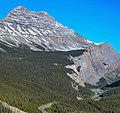| Cirrus Mountain | |
|---|---|
 Cirrus Mountain with summit to left. (Viewed from Parker Ridge) | |
| Highest point | |
| Elevation | 3,270 m (10,730 ft) [1] [2] |
| Prominence | 890 m (2,920 ft) [1] |
| Parent peak | Mount Stewart (3,312 m) [1] |
| Isolation | 5.92 km (3.68 mi) [3] |
| Listing | Mountains of Alberta |
| Coordinates | 52°10′10″N116°58′38″W / 52.16944°N 116.97722°W [4] |
| Geography | |
| Country | Canada |
| Province | Alberta |
| Protected area | Banff National Park White Goat Wilderness Area |
| Parent range | Front Ranges [1] |
| Topo map | NTS 83C2 Cline River [4] |
| Geology | |
| Rock type | Sedimentary |
| Climbing | |
| First ascent | 1939 C.B. Sissons, H.J. Sissons [2] |
| Easiest route | technical climb |
Cirrus Mountain is a 3,270-metre (10,730-foot) mountain summit located in the upper North Saskatchewan River valley on the shared boundary between Banff National Park and White Goat Wilderness Area, in the Canadian Rockies of Alberta, Canada. Cirrus Mountain is situated along the east side the Icefields Parkway midway between Saskatchewan Crossing and Sunwapta Pass. Topographic relief is significant as the summit rises 1,740 m (5,710 ft) above the parkway in 3 km (1.9 mi). The nearest higher peak is Mount Stewart, 5.92 km (3.68 mi) to the north-northeast. [3]






